1995 GMC SIERRA child lock
[x] Cancel search: child lockPage 53 of 488
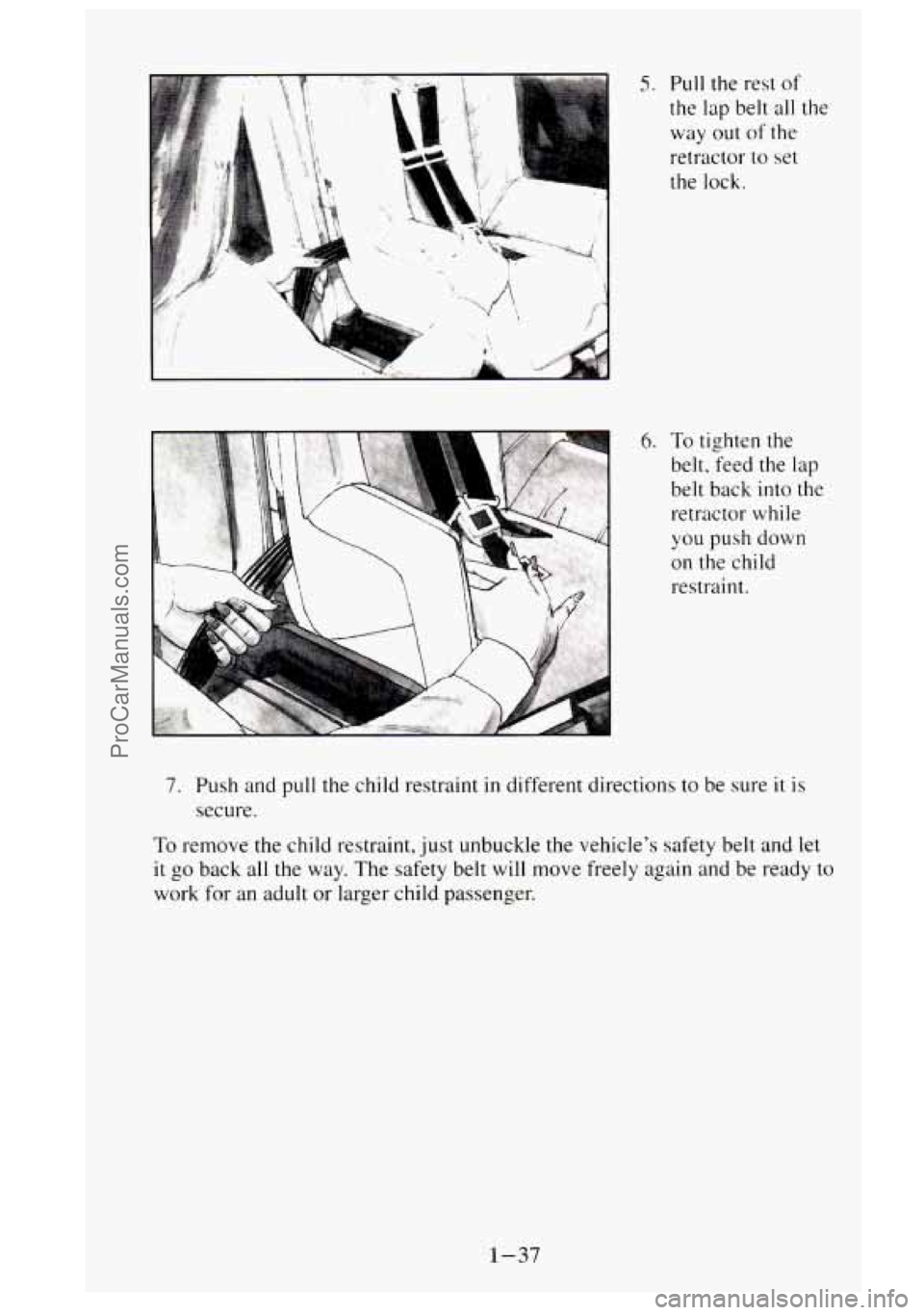
5.
6.
Pull the rest of
the lap belt all
way out of the
retractor
to set
the lock.
the
To tighten the
belt. feed the
lap
belt back into the
retractor while
you push down
on the child
restraint.
7. Push and pull the child restraint in different directions to be sure it is
secure.
To remove the child restraint, just unbuckle the vehicle's safety belt and let
it go back all the way. The safety belt will move freely again and be ready to
work for an adult or larger child passenger.
1-37
ProCarManuals.com
Page 56 of 488
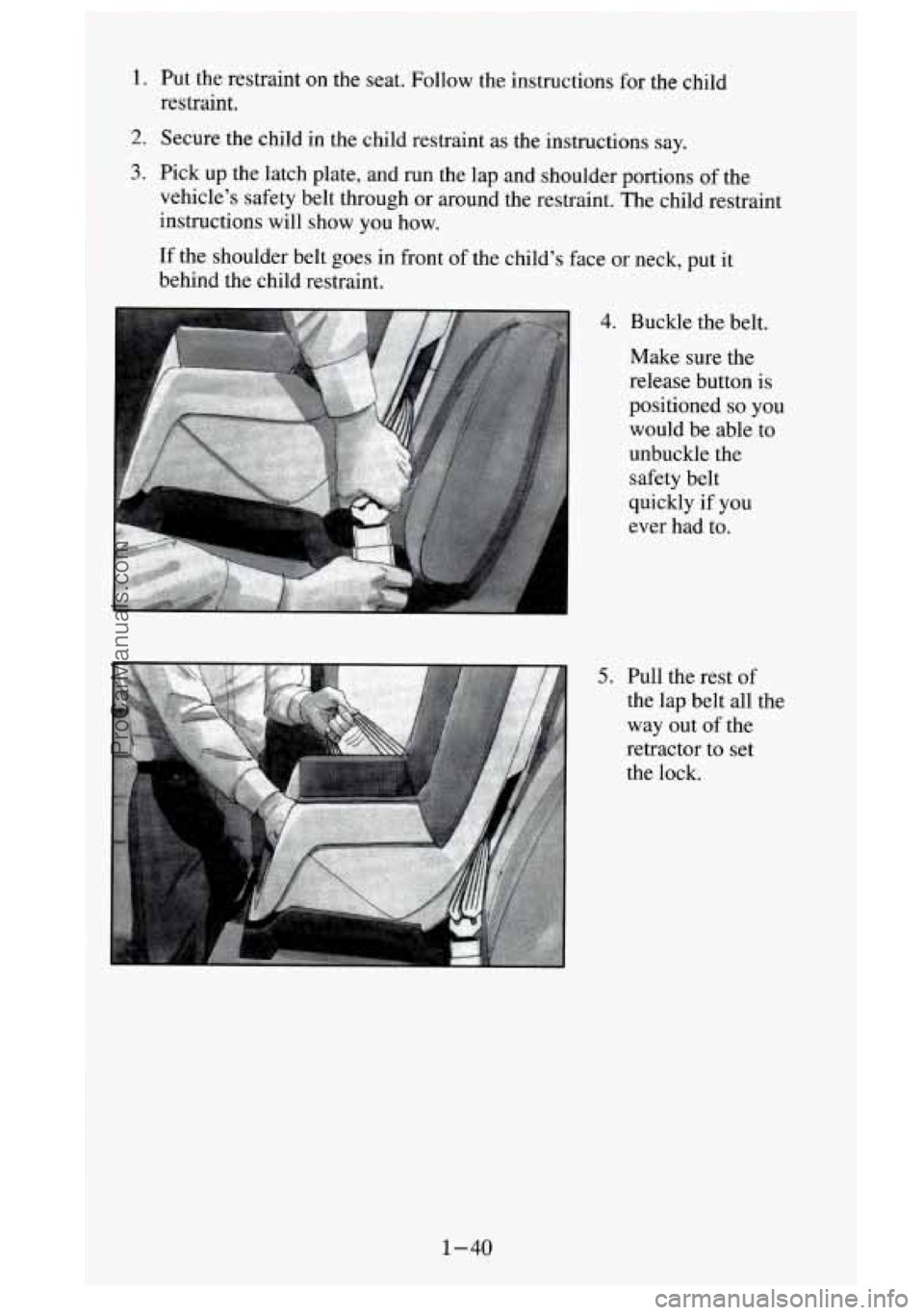
1. Put the restraint on the seat. Follow the instructions for th.e child
restraint.
2. Secure the child in the child restraint as the instructions say.
3. Pick up the latch plate, and run the lap and shoulder portions of the
vehicle’s safety belt through or around the restraint. The child restraint
instructions will show you how.
If the shoulder belt goes in front of the child’s face or neck, put it
behind the child restraint.
4. Buckle the belt.
Make sure the
release button is
positioned
so you
would be able to
unbuckle the
safety belt
quickly if you
ever had to.
5. Pull the rest of
the lap belt
all the
way out of the
retractor to set
the lock.
1-40
ProCarManuals.com
Page 67 of 488
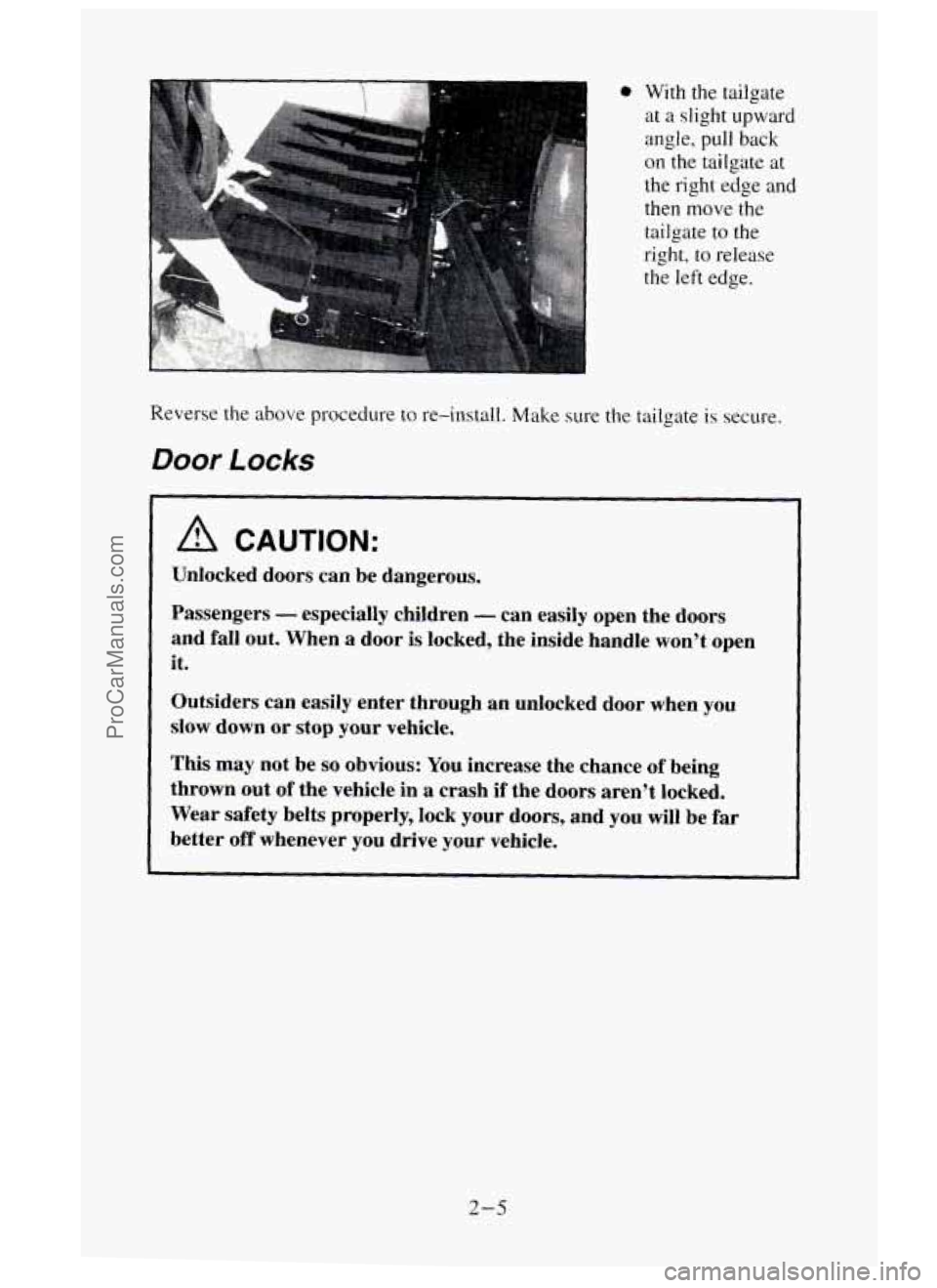
0 With the tailgate
at a slight upward
angle,
pull back
on the tailgate at
the right edge and
then move the
tailgate to the
right,
to release
the left edge.
Reverse
the above procedure to re-install. Make sure the tailgate is secure.
Door Locks
A CAUTION:
Unlocked doors can be dangerous.
Passengers
- especially children - can easily open the doors
and fall out. When a door is locked, the inside handle won’t open
it.
Outsiders can easily enter through an unlocked door when you
slow down or stop your vehicle.
This may not be
so obvious: You increase the chance of being
thrown out
of the vehicle in a crash if the doors aren’t locked.
Wear safety belts properly, lock your doors, and
you will be far
better
off whenever you drive your vehicle.
2-5
ProCarManuals.com
Page 182 of 488
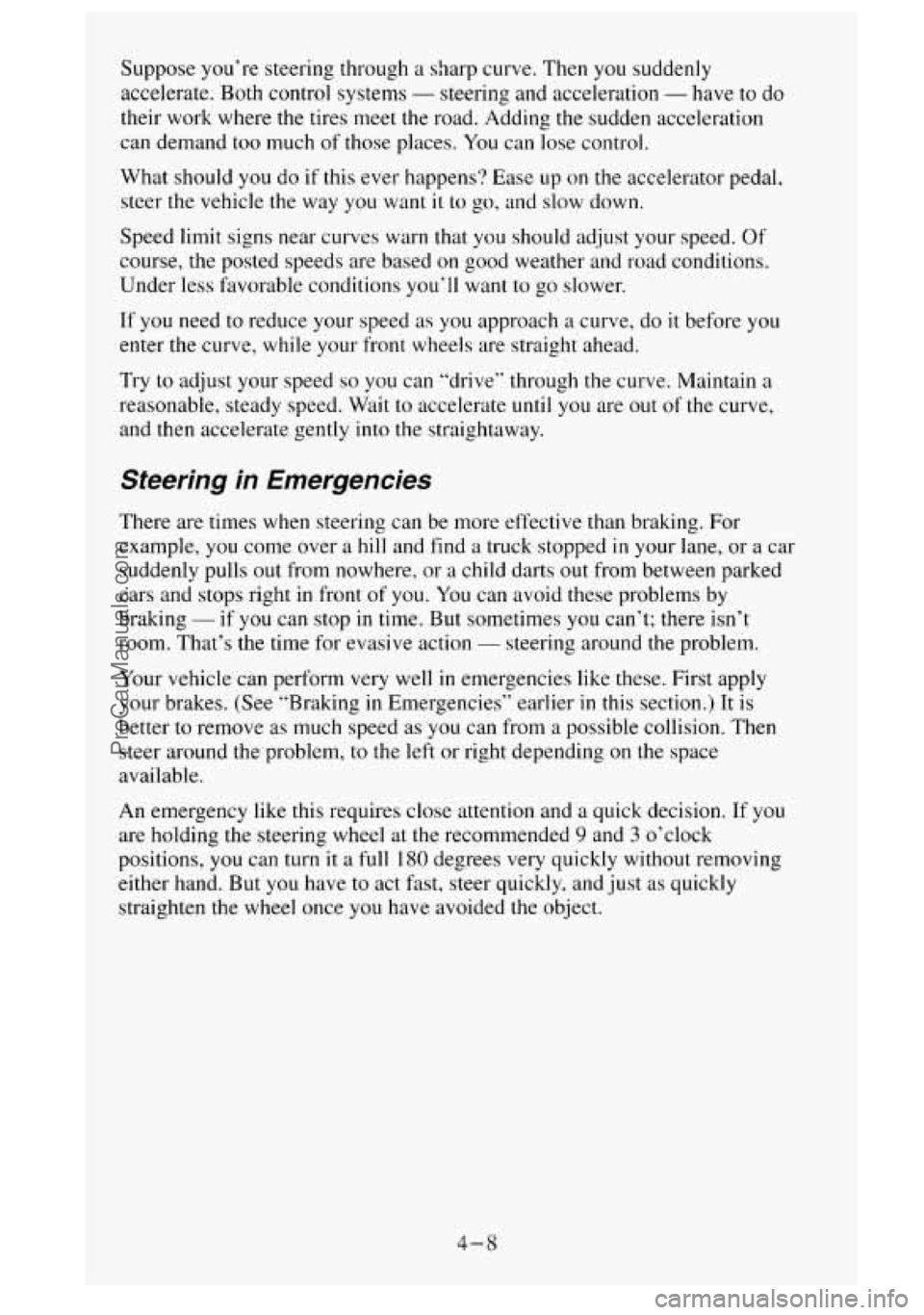
Suppose you’re steering through a sharp curve. Then you suddenly
accelerate.
Both control systems - steering and acceleration - have to do
their work where the tires meet the road. Adding the sudden acceleration
can demand too much of those places. You can lose control.
What should you do if
this ever happens‘? Ease up on the accelerator pedal,
steer the vehicle the way you want
it to go, and slow down.
Speed limit signs near curves warn that you should adjust your speed.
Of
course, the posted speeds are based on good weather and road conditions.
Under less fivorable conditions you’ll want to go slower.
If you need to reduce your speed as
you approach a curve, do it before you
enter the curve, while your front wheels are straight ahead.
Try
to adjust your speed so you can “drive” through the curve. Maintain a
reasonable, steady speed. Wdit to accelerate until you are out of the curve,
and then accelerate gently
into the straightaway.
Steering in Emergencies
There are times when steering can be more effective than braking. For
example, you come over a
hill and find a truck stopped in your lane, or a car
suddenly
pulls out from nowhere, or a child darts out from between parked
cars and stops right in front of you. You can avoid these problems by
braking
- if you can stop in time. But sometimes you can’t; there isn’t
room. That’s the time for evasive action
- steering around the problem.
Your vehicle can perform very
well in emergencies like these. First apply
your brakes. (See “Braking in Emergencies” earlier
in this section.) It is
better to remove
as much speed as you can from a possible collision. Then
steer around the problem, to the left or right depending on the space
available.
An emergency like this requires close attention and a quick decision. If you
are holding the steering wheel at the recommended
9 and 3 o’clock
positions, you can turn
it a full 180 degrees very quickly without removing
either hand. But you have to act fast, steer quickly, and just as quickly
straighten the wheel once you have avoided the object.
4-8
ProCarManuals.com
Page 474 of 488
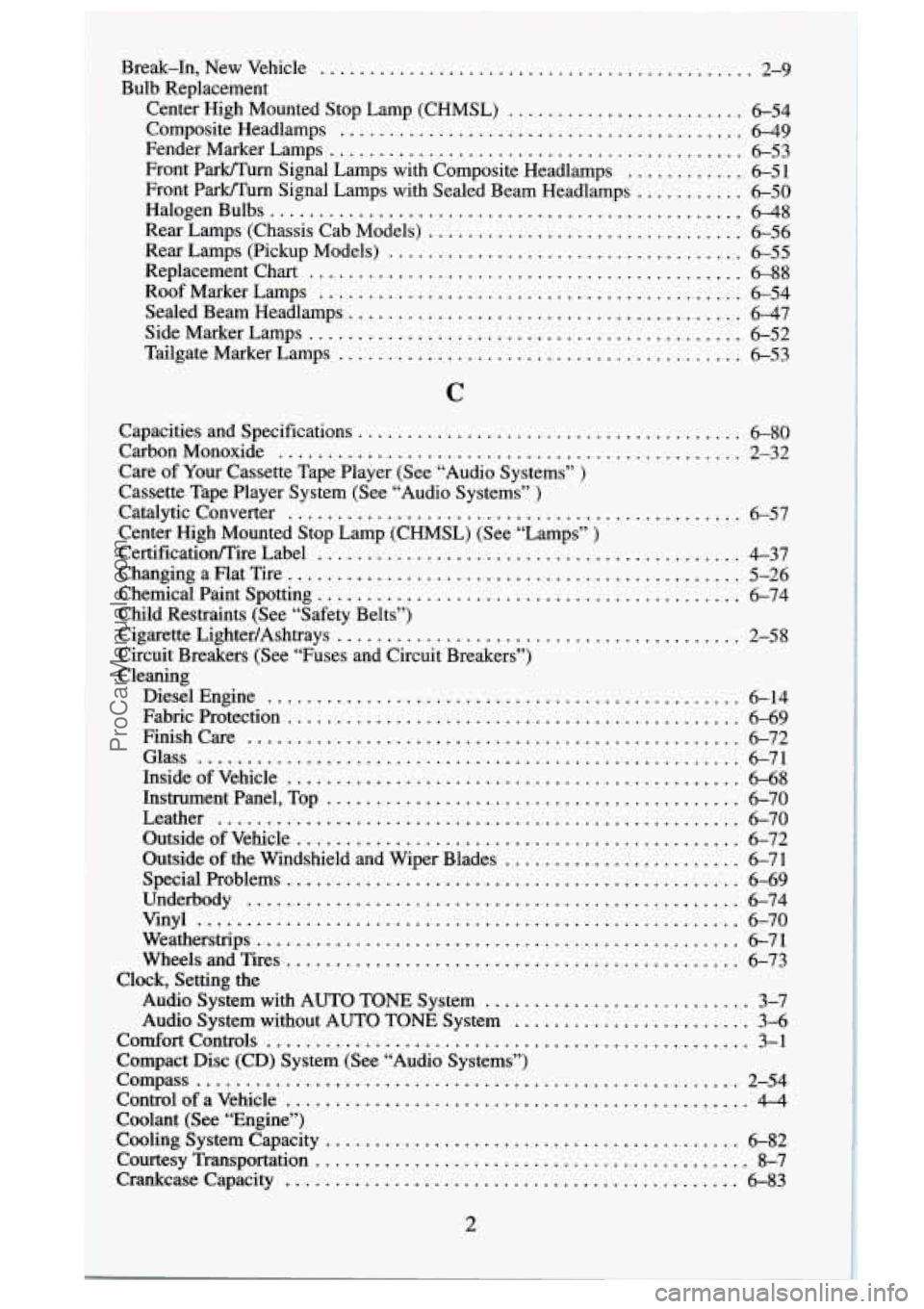
Break.In. New Vehicle ............................................ 2-9
Composite Headlamps ......................................... 6-49
Bulb Replacement Center
High Mounted Stop Lamp (CHMSL) ........................ 6-54
Fender Marker Lamps .......................................... 6-53
Front Park/Turn Signal Lamps with Composite Headlamps ............ 6-51
Front Park/Turn Signal Lamps with Sealed Beam Headlamps ........... 6-50
HalogenBulbs ................................................ 6-48
Rear Lamps (Chassis Cab Models) ................................ 6-56
Rear Lamps (Pickup Models) .................................... 6-55
Replacement Chart ............................................. 6-88
Roof Marker Lamps ........................................... 6-54
Sealed Beam Headlamps ........................................ 6-47
Side Marker Lamps ............................................ 6-52
Tailgate Marker Lamps ......................................... 6-53
C
Capacities and Specifications ....................................... 6-80
CarbonMonoxide ............................................... 2-32
Care of Your Cassette Tape Player (See “Audio Systems” )
Cassette Tape Player System (See “Audio Systems” )
Catalyticconverter .............................................. 6-57
Center High Mounted Stop Lamp (CHMSL) (See “Lamps” )
Certificatioflire Label ........................................... 4-37
Changing a Flat Tire .............................................. 5-26
Chemical Paint Spotting ........................................... 6-74
Cigarette LightedAshtrays ......................................... 2-58
Child Restraints (See “Safety Belts”)
Circuit Breakers (See “Fuses and Circuit Breakers”)
Cleaning DieselEngine
................................................ 6-14
Fabric Protection .............................................. 6-69
Finishcare .................................................. 6-72
Glass ....................................................... 6-71
InsideofVehicle .............................................. 6-68
Leather ..................................................... 6-70
Instrument Panel, Top .......................................... 6-70
Outside of Vehicle ............................................. 6-72
Outside of the Windshield and Wiper Blades ........................ 6-71
Special Problems .............................................. 6-69
Vinyl ....................................................... 6-70
Weatherstrips ................................................. 6-71
Audio System with AUTO TONE System ........................... 3-7
Audio System without AUTO TONE System ........................ 3-6
Underbody .................................................. 6-74
WheelsandTires .............................................. 6-73
Clock, Setting the
ComfortControls
................................................. 3-1
Compact Disc (CD) System (See “Audio Systems”)
Compass
....................................................... 2-54
Control of a Vehicle ............................................... 4-4
Coolant (See “Engine”)
Cooling System Capacity
.......................................... 6-82
Courtesy Transportation ............................................ 8-7
CrankcaseCapacity .............................................. 6-83
2
ProCarManuals.com
Page 481 of 488

Seats (continued) Reclining Front Seatbacks
....................................... 1-3
Seatback Latches
........................................... 14. 1-8
Doing Your Own Service Work ................................... 6-1
Parts Identification Label
.....................
Service
Publications
.................................
Replacement Parts and Filter Recommendations ....
Service Engine Soon Light (See “Lights”)
Servicing Your Air Bag-Equipped Vehicle (See “Supple
System (SIR)”)
Shift Indicator Light (See *‘Lights“)
Shifting Into Park (P)
...........................
Shifting Out of Park .............................
Shock Absorbers (Front) .........................
.................. 6-78
.................. 8-8
....... 6-80.6-84,6-85
:r nental Inflatable Restraint
................. 2-28
................. 2-29
................. 6-45
Specifications Chart (See “Service . Replacement Parts and Filter
Recommendations“) SpareTire
................................................. 5-28.5-29
Speedometer and Odometer (See “Gages”)
Starting Your Engine (See ”Engine-Starting”)
Steering
........................................................ 4-7
Column Shift Lever
............................................ 2-29
InEmergencies
................................................ 4-8
Tips
......................................................... 4-7
Step-Bumperpad ................................................ 2-84
Storage Compartments
............................................ 2-59
Sunvisors
..................................................... 2-57
Supplemental Inflatable Restraint System (SIR)
........................ 1-19
Adding Equipment to Your Facial Air Bag-Equipped Vehicle
.......... 1-23
How the Air Bag System Works .................................. 1-20
Servicing Your Air Bag-Equipped Vehicle
......................... 1-23
Surge Tank Pressure Cap
.......................................... 6-39
T
Tachometer (See “Gages”)
Tail~ate
......................................................... 2-4
Removal ..................................................... 2-4
TIleft ........................................................... 2-8
Thermostat
..................................................... 6-40
Tilt Wheel (Option) .............................................. 2-38
Tires
.......................................................... 6-58
Balancing (See “Wheel Alignment and Tire Balance”)
Chains
...................................................... 6-66
Dual Tire Operation ........................................... 6-62
Flat (See ”Changing
a Flat Tire”)
Inspection and Rotation
........................................ 6-59
Loading (See “Loading Your Vehicle”)
New
........................................................ 6-63
Pressure
..................................................... 6-58
Spare (See ”Spare Tire”)
Uniform Tire Quality Grading
................................... 6-63
Top Strap (See “Safety Belts-Child Restraints“)
Torque Lock (See “Transmission-Torque Lock“)
9
ProCarManuals.com